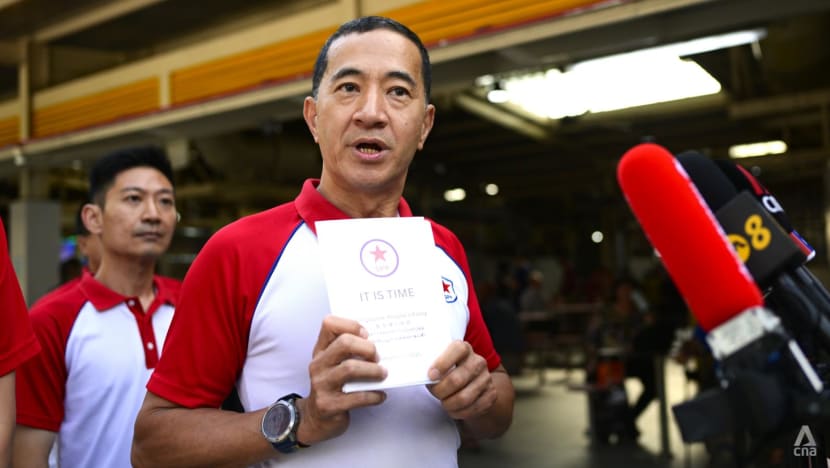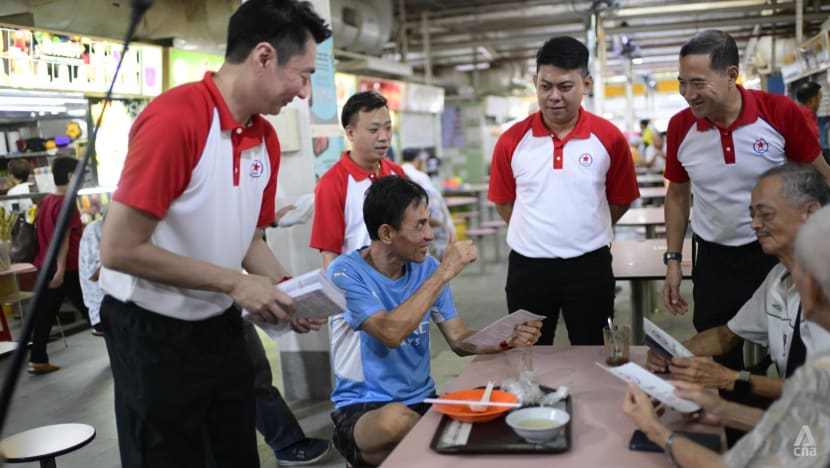I think they should be able to take back their deposit but that's about all, LOL.
https://www.channelnewsasia.com/singapore/ge2025-singapore-peoples-party-spp-manifesto-5074416
GE2025: Singapore People’s Party unveils manifesto calling for minimum wage, CECA review and reducing NS
Singapore People's Party secretary general Steve Chia speaks to the media to launch SPP's manifesto, next to Toa Payoh Lorong 8 Market and Hawker Centre on Apr 19, 2025. (Photo: CNA/Wallace Woon)
SINGAPORE: The Singapore People's Party (SPP) unveiled its 16-page manifesto on Saturday (Apr 19), calling for a minimum wage policy and to lower the eligibility age for singles who can buy public housing to 30, among other reforms.
Launching the manifesto with the slogan "It Is Time", party secretary-general Steve Chia said: "We believe it's really time to take charge of a lot of the policies and proposals that SPP is going to propose, and hope to propose, if we are elected in this election."
During the event, SPP also revealed five potential candidates for
Potong Pasir SMC and the four-member
Bishan-Toa Payoh GRC, but did not confirm who will contest in which area.
They are: Mr Chia, party chairman Melvyn Chiu, operations executive Muhammad Norhakim, as well as Mr Williamson Lee and Mr Lim Rui Xian,
who are both self-employed.
The party fought for the same two constituencies during the 2020 General Election.
This will be Mr Chia’s sixth time standing in a General Election. He was a Non-Constituency Member of Parliament from 2001 to 2006 – landing the seat after he contested Chua Chu Kang SMC under the Singapore Democratic Alliance’s banner.
Mr Lim, 37, previously volunteered with the National Solidarity Party (NSP) since 2015, and became an SPP member in March this year.
The self-employed owner of a cleaning company was recently spotted wearing NSP colours on a walkabout with The Coalition in Tampines in mid-March.
When asked about why Mr Lim moved from NSP to join SPP, Mr Chiu said: “We are in a coalition. The objective of The Coalition is so that we can have a better permutation of candidates to serve the different constituencies.”
Formed in 2023, The Coalition brought together NSP, SPP, Red Dot United (RDU) and the Singapore United Party, with the aim of fostering greater opposition unity and minimising electoral clashes.
RDU
pulled out of The Coalition earlier this month, citing concerns about NSP’s intention to pursue a three-corner fight in Sembawang GRC with the Singapore Democratic Party.
ADVERTISEMENT
When asked about why he decided to join SPP, Mr Lim said the party does not "just oppose for the sake of opposing... They have a good structure for about how to improve the policy in Singapore."
Singapore People's Party's (SPP) potential candidates (from left) Melvyn Chiu, Lim Rui Xian, Muhammad Norhakim and Steve Chia interact with diners at the Toa Payoh Lorong 8 Market & Hawker Centre on Apr 19, 2025. (Photo: CNA/Wallace Woon)…see more
Mr Norhakim, 31, and Mr Lee, 46, also spoke in turn to introduce some of the party’s proposed policies. This will be Mr Norhakim’s first election.
After speaking to journalists, they interacted with and gave out hard copies of their manifesto to residents at Lorong 8 Toa Payoh Market and Hawker Centre.
The document features 40 policy proposals across nine themes to address “today’s evolving challenges”.
Among the recommendations are a review of the Comprehensive Economic Cooperation Agreement (CECA) between India and Singapore, reducing National Service to 18 months and phasing out ethnic quotas in public housing estates.
SPP also asked the government to amend the Constitution to
allow the proportional representation of smaller opposition parties in parliament.
Here’s a look at SPP’s key proposals in its manifesto for the upcoming election:
COST OF LIVING
Under the manifesto’s first theme of economic stability and fairness, the party noted that Singaporeans face rising costs of living with stagnant wages.
The party suggested that any increases in the Goods and Services Tax be frozen until Singapore’s cumulative budget deficit exceeds 3 per cent of government revenue for three consecutive years.
It called on the government to raise income tax on the top 2 per cent of earners and reintroduce estate duty for ultra-high-net-worth individuals “to fund equitable relief”. SPP also proposed tax reliefs and more vouchers for lower-income groups.
The party proposed a living wage policy to ensure that low-income workers and families can “meet basic needs”. It also recommended setting a minimum wage “to ensure dignity of living”.
JOBS
For employment and job security, the opposition party called for the Tripartite Alliance for Fair and Progressive Employment Practices guidelines to be codified into law, mandating fair hiring and retrenchment benefits.
In its manifesto,
the SPP asked the government to reassess the CECA agreement with India “to address labour inflow concerns”, and gradually reduce Special or Employment Pass quotas and dependency ratios in automatable sectors.
The party proposed enforcing higher local hiring quotas with a raised local qualifying salary, offering tax breaks to businesses prioritising Singaporean professionals, managers, executives and technicians.
The government should also abolish the statutory retirement age of 63 and offer tax incentives for companies hiring seniors aged past 70 who choose to keep working, the party said in its manifesto.
HOUSING AND GOVERNANCE
SPP’s manifesto also covered a slew of housing policies in different areas.
The party wants the government to lower the minimum age for singles to apply for Build-to-Order or resale Housing and Development Board (HDB) flats to 30 years old.
The manifesto also put forward a suggestion for a five-year pilot to relax ethnic quotas in HDB estates to aid “minority flat owners in selling at fair market value”.
Parents with two or more children should get additional grants to help them upgrade to a larger flat, and those with three or more children should be allowed to purchase a private property without Additional Buyer’s Stamp Duty, the manifesto read.
On governance, SPP proposed implementing a freedom of information act, easing defamation laws and implementing a yearly 2 per cent reduction in every ministry’s budget “to cut unnecessary spending”.
Election years and dates should be fixed for a level playing field, and the Electoral Boundaries Review Committee should be removed from the Prime Minister’s Office to “establish an independent commission for free and fair elections”, the party said.
The manifesto also made recommendations in areas of education, healthcare and public transport, including reducing class sizes in school, expanding mental health resources, increasing travel subsidies for low income families and seniors, as well as lowering the voting age to 18.




